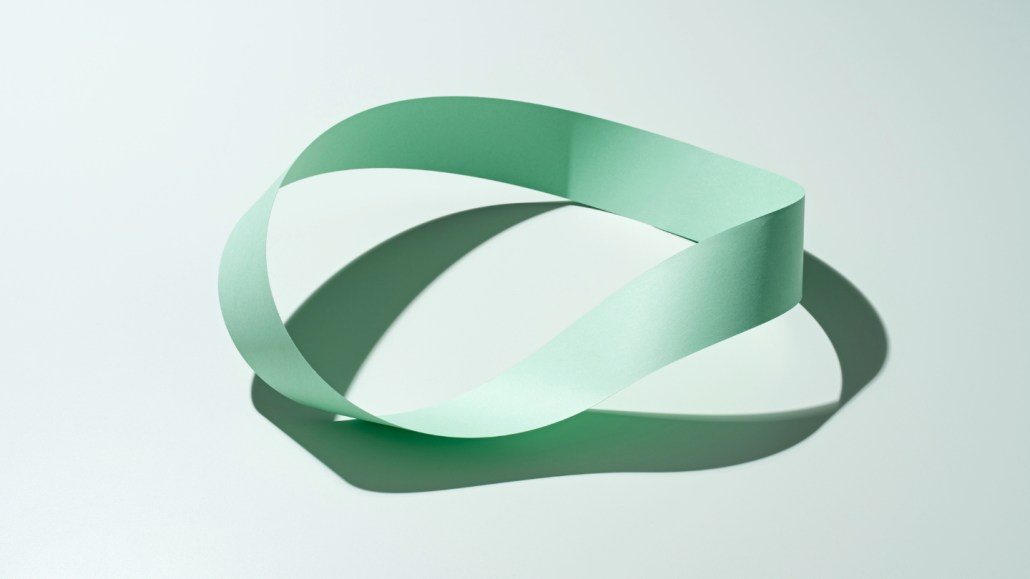A twisty mystery about Möbius strips has been solved at last
Paper and scissors finally helped a mathematician prove how short the loops can be

A Möbius strip (one shown) is a loop of paper with a half-twist in it. A mathematician has now solved a nearly 50-year-old stumper: What’s the shortest possible Möbius strip for a given width?
MirageC/Moment/Getty Images Plus
Share this:
- Share via email (Opens in new window) Email
- Click to share on Facebook (Opens in new window) Facebook
- Click to share on X (Opens in new window) X
- Click to share on Pinterest (Opens in new window) Pinterest
- Click to share on Reddit (Opens in new window) Reddit
- Share to Google Classroom (Opens in new window) Google Classroom
- Click to print (Opens in new window) Print
Any attempt to better understand twisty strips of paper is bound to run into some kinks. But one mathematician solved a lingering mystery after playing with paper and scissors.
The twisty paper strips are called Möbius strips. Anyone can make these mathematical oddities. First, cut a strip of paper. Then twist one end halfway around and tape the two ends together to form a loop with a twist in it. The result is a one-sided surface. You can confirm this by tracing your finger along the surface. Your finger will travel over every part of the band before returning to where it started.
The twisted loops have inspired artists and researchers in many fields. They’re so strange, in fact, that mathematicians have struggled to answer some basic questions about them. For example: For a paper band with a given width, what’s the shortest Möbius strip you can make?
A long, skinny Möbius strip is easier to make than a stumpy one. With a very short strip, the paper has to contort so much that it flattens into an equilateral triangle. (Try this for yourself. Slowly pull one end of an untaped Möbius strip to shorten it. You’ll see it form the triangle shape.) The triangular Möbius strip has a length that’s the square root of 3 — written √3 — or about 1.73 times its width.
In 1977, mathematicians hypothesized that the triangular Möbius strip was as short as you can go. They had imagined a paper version that is infinitely thin, smooth and nonstretchy. But no one had been able to prove that hypothesis. Mathematicians could show only that the ratio between a Möbius strip’s length and width must be greater than pi divided by 2, or about 1.57.
The question hooked mathematician Richard Evan Schwartz. He works at Brown University in Providence, R.I. He’s fond of simple math problems that stump even the experts. “I like it when no one has any idea what to do,” he says. A bonus: “If I bomb out on this, there’s no shame in it. I’m just like everybody else.”
Schwartz focused on a key property of Möbius strips: straight lines.

The paper curves this way and that to form the loop, of course. But at every point on the band, there’s a direction in which the paper follows a straight line from edge to edge, with no curve. (That’s not true of all surfaces. Think of a bowl: There are no straight lines to be found.) He realized that in any Möbius strip there must always be two such lines that are perpendicular and in the same plane (as in the letter T).
Based on how the paper contorts to form this T shape, Schwartz found a new minimum length-to-width ratio. To his disappointment, it was not exactly √3. But it was very close: about 1.69. He reported this result in Geometriae Dedicata in 2021.
Schwartz moved on to other topics but couldn’t stop thinking about the problem. One day, on a whim, he began playing with strips of paper. In a head-smacking jolt, he realized he’d made an error.
Computer bug
Schwartz had assumed that slicing open a Möbius strip along a diagonal and flattening it would form a parallelogram. That’s a four-sided shape in which each pair of opposing sides are parallel. But when Schwartz cut open one of his paper Möbius strips, that’s not what he saw. It formed a trapezoid, in which only two sides are parallel. “I instantly said, ‘Uh oh,’” he recalls.
It was a simple mistake. But Schwartz had been studying Möbius strips mainly on the computer. Turns out, he’d flubbed the setup of his computer program. That led to the parallelogram goof. “Once I’d made the mistake,” he says, “it’s like it got locked into my brain.”
Schwartz says he hardly ever used paper Möbius strips in his research. But that’s what it took to jolt him out of his set pattern of thought. It’s a bit curious that Schwartz didn’t turn to paper earlier. He fiddles with paper as a hobby to design elaborate paper masks.
Once Schwartz redid the calculation with the trapezoid fix, √3 popped out. He’d finally proved that the length-to-width ratio of a Möbius strip must be greater than √3. He shared the discovery August 24 at arXiv.org. The triangular Möbius strip is truly the limit for paper Möbius strips.
Now, Schwartz is interested in taking this work further. What, he wonders, is the minimum length for a Möbius strip with more twists? This time, perhaps, he’ll spend more time playing with paper.







